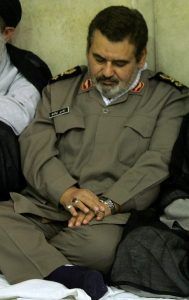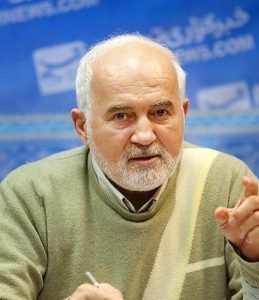In recent months in Iran, serious questions have been raised about the rightful ownership of homes that were seized after the 1979 Revolution and subsequently allocated to senior officials of the regime. Hassan Firouzabadi, the former chief of staff of Iran’s Armed Forces, had to vacate his house in Lavasan (Shemiranat County, Tehran Province) after it emerged that he did not hold the title deeds to the property.

10 July 2010. Source: Wikimedia Commons
The controversy surrounding this issue has forced many senior officials to prove rightful ownership of their properties — including Ali Akbar Velayati, a senior adviser on international affairs to Iran’s Supreme Leader Ayatollah Ali Khamenei. In a May interview with the online Panjereh Weekly [www.panjerehweekly.ir], Dr. Velayati explained how he and his family had moved into their current house nearly 30 years ago.
Mr. Velayati said: “I sold my office in 1982. At the time, the Monafeghin [People’s Mojahedin of Iran, MKO] had intensified their terrorist operations in Tehran. It was dangerous for me to receive patients at my practice. We bought an old house in Tajrish in Shemiranat County, Tehran Province. I received a loan of $118,000 from Mr. Asadollah Asgaroladi [the richest person in Iran, with a net worth of $9 billion] to rebuild the house. The current Friday prayers leader of Shemiranat, Mr. Mohsen Doagou, was the head of the local [Revolutionary] Committee at the time. He told me that it wasn’t safe for my family and me to live at that location. I asked for his help in finding a new house.”
Velayati added: “At the time, the local Committee had set up offices at the Saadabad Complex [Shemiranat, Tehran, built by the Qajar and Pahlavi dynasties]. There was a house near the complex owned by the Foundation of Martyrs and Veterans. I asked the head of the foundation, Mr. Mehdi Karubi, [the former Speaker of the Parliament, currently under house arrest] if it was possible for me to exchange homes. They valued our house and the one near the Committee in 1993 for $284,000 and $401,000, respectively. I paid $118,000 of the difference in cash and the rest in $5,000 monthly installments.”
While Velayati holds the title deeds to the house, it was forcibly and wrongfully seized after the Revolution, and therefore does not rightfully belong to him or to Mr. Karubi or to the Foundation of Martyrs and Veterans. Based on the current market value of similar properties in the area, the land alone where the house sits is worth more than $7 million dollars.
[aesop_image img=”https://kayhanlife.com/wp-content/uploads/2018/07/Syrian_President_Bashar_al-Assad_meets_Irans_special_representative_on_Syrian_affairs_Ali_Akbar_Velayati.jpg” panorama=”off” align=”center” lightbox=”on” caption=”Syrian President Bashar al-Assad meets Iran’s special representative on Syrian affairs, Ali Akbar Velayati
” captionposition=”left” revealfx=”off” overlay_revealfx=”off”]
Velayati explained: “The property was originally 1,000 square meters. We donated 224 square meters of the land for the building of a Hussainiya [congregation hall for Shia ceremonies]. We recently donated another 200 square meters to expand the Hussainiya. So we live in the remaining 600 square meters. My four children and their families occupy the top two floors. My wife and I live on the ground floor. So five families live in this building.”

Another person who has been in the news recently is Ahmad Tavakoli, a former Majlis (Iranian Parliament) deputy representing Tehran, Shemiranat, and Eslamshahr. He is currently the managing editor of the online Aref news website. In the early 1990’s, Mr. Tavakoli and few others purchased a 3,000- square-meter plot of land in Shahrak-e Gharb (Qods Town), northwestern Tehran, from the MFJ at the discounted price of $132,000. The market value of the property at the time was more than $1 million.
Mohsen Rafighdoost was the director of the MFJ at the time. The agreement called for Tavakoli to pay the money in 10 years. According to Tavakoli, the plan was to build an educational complex on the land. He said that on a recommendation from Mr. Khamenei, the MFJ agreed for the money to be paid in installments. In 2011, former First Vice President Mohammad Reza Rahimi said the land was worth nearly $12 million.
In recent days, other names have surfaced in the media over state-sanctioned land-grabbing schemes, including former President Mohammad Khatami (1997-2005) and the former Minister of Intelligence Ali Fallahian (1989-97), who was reportedly a crucial figure in the mass murder of dissidents, political prisoners, intellectuals and MKO members in the 1980s.
There is currently a concerted effort by Iranians on social media to identify homes and properties that the regime forcibly and unlawfully seized after the 1979 Islamic Revolution. The rightful owners of these properties are urged to post title deeds and all other relevant documents online. Many people have been expressing their anger and outrage at the gross injustices committed by the regime.
@sabaazarpeik tweeted: “Former Intelligence Minister Fallahian owns one of those confiscated villas in Pol-e Rumi, Tehran. I went to see him one day at prayer time. I asked how he could pray in a confiscated house. He said the house was the spoil of an Islamic war! (War: 1979 Revolution) He failed to mention that they revolted against the palaces!”
@yasharsoltani wrote: “Perhaps Mr. Velayati could take a break from his busy schedule and explain who was the rightful owner of the house he has been living in all these years.”
In some instances, attempts to target and expose these individuals are coordinated and guided by people with a particular agenda. A report in Kayhan London deals specifically with the infighting among various factions inside the regime.
For instance, the Iranian Justice Seeker Student Movement, a group closely linked to the regime’s security apparatus, was instrumental in questioning Firouzabadi’s ownership of his house in Lavasan. The group is made up of young student Basij and religious fundamentalists active in universities. The question about the rightful owner of the villa in Lavasan was a well-protected secret for two decades. The recent revelations show the increasing tensions and conflicts among various factions in Iran.
Meanwhile, some journalists from the reformist camp have shared their findings on confiscated properties on social media. It is possible that some factions within the establishment are leaking damaging information about their opponents to the media.
[Translated from Persian by Fardine Hamidi]

